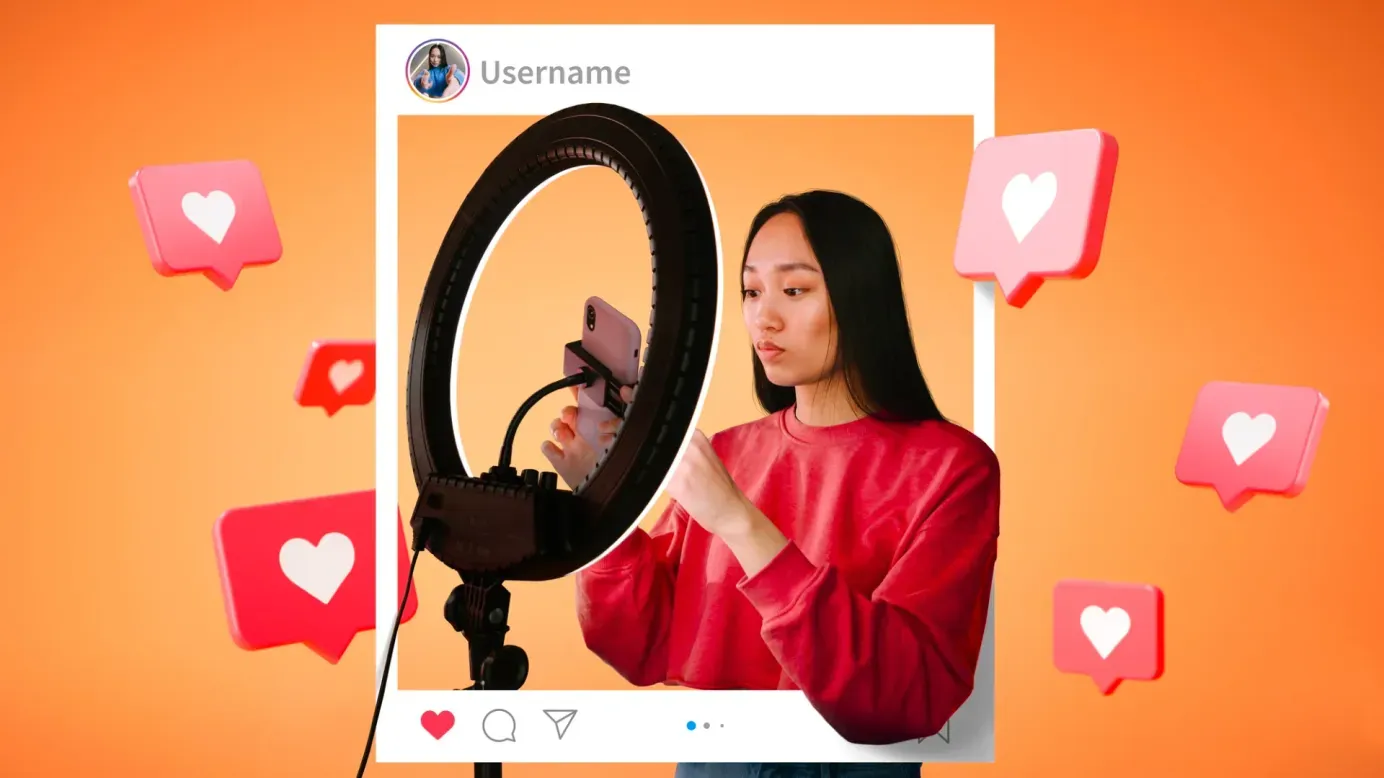A Guide to Influencer Marketing and Amazing Strategies to Make It Effective
Explore this comprehensive guide to influencer marketing—what it is, why it matters, and how to build impactful campaigns. Learn key strategies, influencer types, campaign formats, and how to manage and reward partnerships for long-term success.
On this page
Influencer marketing has become a buzzword in the world of digital marketing, and for good reasons. With the rise of social media platforms, influencers have gained massive success and the ability to sway the purchasing decisions of their audiences.
Brands have taken notice of and are leveraging the power of influencer marketing to reach new audiences, increase brand awareness, and drive sales. According to Aspire, 63% of marketers say influencer-generated content performs better than other brand content.
However, if you're new to the world of influencer marketing, it can be overwhelming to know where to start. In this blog post, we'll cover the basics of what influencer marketing is, how it works, and some tips on how to do it effectively.
Whether you're a brand looking to partner with influencers or an influencer looking to collaborate with brands, this post will provide you with a solid foundation to get started.
What is influencer marketing?
Influencer marketing is a recent development in marketing strategies, where businesses collaborate with individuals who have a fan following on social media platforms. These individuals are called influencers.
Influencer marketing has been creating a great buzz in recent times. Individuals who have been able to generate a following in their niche are a wonderful channel to build brand awareness.
Importance of influencer marketing
This relatively new form of marketing has gained immense popularity. The following are some pointers that stress its importance:
- Influencer marketing helps improve brand awareness. Influencers provide more exposure to brands and help them achieve the desired reach.
- Since influencers concentrate on a niche, it is easy to precisely target prospective customers through this form of marketing.
- Influencers who have gained a lot of followers can forge better engagement. This helps the brand scale more.
- Collaborating with an influencer can help boost conversion rates. Through their unique style of marketing, they help generate more customers.
- Audiences trust influencers more than an advertisement in conventional media. The trust can be converted easily to make them your customers.
- Brands can explore new landscapes and reach newer audiences through influencer marketing.
Types of influencer marketing campaigns
Influencer marketing isn’t one-size-fits-all — it comes in many formats tailored to different goals and audiences. Here are some widely used approaches:
1. Affiliate or discount codes
Influencers share personalized discount codes or trackable affiliate links with their followers. This tactic is ideal for driving direct conversions and rewarding influencers with commissions for every sale they generate.
2. Contests and giveaways
An influencer host a giveaway featuring your product or service, encouraging engagement and new followers for both your brand and the influencer. It’s an effective tactic to boost reach and grow communities.
3. Sponsored content
In this model, brands pay influencers to create and share content featuring their products. Sponsored posts work well for building brand awareness by tapping into the influencer’s existing audience and credibility.
4. Product gifting
Instead of paying a fee, brands send products to influencers in exchange for coverage. This approach is useful for early-stage awareness, especially with micro or nano influencers open to barter collaborations.
5. Social media takeovers
The influencer temporarily takes control of your brand’s social media account, sharing behind-the-scenes content or hosting Q&As. This format increases engagement and brings their followers directly to your page.
6. Co-creation and collaborations
This involve partnering with an influencer to develop new content, limited-edition products, or campaigns. These collaborations are valuable for brand-building and sales — especially when targeting niche audiences.
Each of these strategies offers its own unique benefits. The right fit depends on your campaign objectives, available budget, and the type of influencer partnership you're aiming to build.
Though people often use the terms influencer marketing and influencer collaboration interchangeably, they actually refer to different approaches — and understanding the distinction can help you use both more effectively.
Influencer marketing is the broader strategy. It includes any form of partnership with influencers where they promote your brand, typically through sponsored content, product reviews, discount codes, or giveaways.
Influencer collaboration, on the other hand, is a specific type of influencer marketing. It involves co-creating something new — whether it’s a product line, a campaign, or a unique piece of content — that reflects both the influencer’s personal brand and your company’s identity. This approach is more integrated, with a focus on authenticity and shared value for both audiences.
A standout example of this is the #elfxonabela campaign, where e.l.f. Cosmetics partnered with beauty influencer Nabela Noor to co-create a makeup collection that celebrated inclusivity and resonated with both the brand’s and the influencer’s communities.
Understanding the types of influencers
Alongside choosing the right type of campaign, it’s just as important to understand the different categories of influencers based on their audience size and reach.
While influencers often focus on specific niches — like food, fitness, finance, or fashion — we’re going to look at them through the lens of their follower count. This helps you gauge potential reach and plan your strategy accordingly.
Here are the four main tiers of influencers:
- Mega-influencers: With over 1 million followers, these individuals have massive audiences and wide-reaching influence (think Gary Vaynerchuk or Amanda Seales). While celebrities often fall into this category, they’re in a league of their own when it comes to cultural impact beyond social platforms.
- Macro-influencers: These influencers have between 100,000 and 1 million followers. They’re often well-known within their niche and can offer significant exposure. Examples include Neil Patel or Julissa Prado.
- Micro-influencers: Ranging from 10,000 to 100,000 followers, micro-influencers typically have more engaged audiences and stronger community ties. Think Goldie Chan or Milang Garcon.
- Nano-influencers: These influencers have fewer than 10,000 followers and often maintain highly personal connections with their audience — like Noelle Graham.
Understanding the size of an influencer’s following gives you a solid baseline for estimating reach. Pair that with engagement metrics, and you’ll have the insight needed to define campaign goals, performance benchmarks, and compensation models effectively.
How to build an influencer marketing strategy?
You should have a strong strategy in place to create brand awareness and reach your target audience through influencers. Here are some tips to build an influencer marketing strategy:
1. Define your goals
What do you want to achieve by roping in influencers for marketing? Do you want to generate a customer base in new demography, increase sales, generate brand awareness, or promote a new product?
Defining goals will help you formulate ways to reach them. Your goals also act as benchmarks to follow up on your performance.
Proper goal definition also enables the influencers to strategically focus on attracting more prospects.
2. Define your audience
Your target audience plays a great role in framing marketing strategies. Identify and segment your audience to structure your campaigns.
Target audiences can be segmented based on geography, demography, stage in the customer lifecycle, etc.
Defining your audience helps the marketing teams greatly. It is also easy to identify the influencer who can suit your campaigns.
3. Define your budget
Among other factors, budget is an important one. It is the main constraint in deciding the influencer, type of content, campaign, platform, etc.
If you are a small-sized business, you will not be able to spend much on marketing. So, an influencer agency that needs higher compensation will be an expensive choice.
Arrive at your budget first, depending on your industry and campaign, and then proceed to look for influencers.
4. Choose the kind of campaign
The types of campaigns can vary depending on the buyer segment and also the products/services. Each kind of campaign has its advantages.
You could opt for premium guest posts, giveaways or contests, coupon codes, promotions, affiliates, etc. When you have a clear understanding of your buyer persona, it is easy to decide the type of campaign.
You should also consider the influencer’s forte while deciding the type of campaign.
5. Consider the 3 Rs of influencer marketing
It is imperative to consider the 3Rs while choosing an influencer for your marketing programs. The 3 Rs are:
- Relevance: The influencer should be relevant to your target audience. You should choose an influencer who can cater to your niche. This is highly crucial to get the desired reach.
- Reach: Reach determines the number of people the influencer should reach out to. It depends on the number of followers and how many of them are likely to engage with the content created by the influencer.
- Resonance: Can the influencer help increase your customer count? Many followers just visit the page and enjoy the content but do not show any progress beyond that. This is not the result you expect from influencer marketing. The influencers should be able to pass on your brand’s value and help them move down the funnel.
6. Decide the platform
While there are several platforms available, the choice of one for your brand will depend on your requirements and budget. It may be YouTube, Instagram, Facebook, Twitter, personal blogs, Snapchat, TikTok, etc.
Choose a platform that is popular and where your influencer has a good reach. The kind of products/services you want to promote also has a bearing in deciding on the platform.
For example, household products can be easily marketed through Instagram influencers.
7. Selection of influencers
The influencer you choose should be the perfect voice for your brand. Since the increase in the popularity of social media marketing, there has been considerable growth in the number of influencers.
But to choose the right influencers for your brand, you should consider the following:
- Have the influencers worked with similar brands earlier?
- Are the influencers endorsing your competitor brands?
- Do they have knowledge about your industry?
- Do they fit your brand values?
- How about their engagement with the audience?
- Will they fit your budget?
Qualify your influencers and reach out to them with your requirements. You can plan the way you want your campaigns to be executed.
8. Develop a plan for launch and promotion
It’s essential to create a clear plan for launching and promoting the campaign once the content and collaboration are finalized. The question then becomes: how will the brand ensure people actually see it?
Although the influencer plays a central role in marketing the product, the relationship is a true partnership. As Corley emphasized, brands should look for opportunities to support the influencer, their objectives, and their audience. Effective partnerships thrive on mutual benefit.
Brands should amplify the campaign through their own channels, by sharing links on social media, mentioning it in email newsletters, writing a related blog post, or issuing a press release. Taking an active role in promoting the campaign not only maximizes reach but also reinforces the partnership. All potential promotional tactics should be thoughtfully outlined in the campaign strategy.
9. Use rewards and incentives
Rewards are a great way to attract potential leads. It is a win-win for both the brand and the customers. While it acts as a brand promotional strategy, the customers also get free goodies.
Incentive programs are highly essential where marketing has taken a virtual stage. Since there is no face-to-face interaction with potential customers, it is necessary to keep them engaged with e-gifts.
10. Manage the campaigns
Selection of an influencer for your brand can be done through direct interaction, agencies, or influencer marketing tools. This depends on your budget and requirements.
You have to plan and manage your campaigns with the influencers. You should convey your brand guidelines so that influencers can plan a strategy accordingly.
Similarly, you should also acquaint yourself with how the influencer works with other brands, what kind of reciprocation they expect, etc.
You should also decide upon the terms of the contract, whether you need to put it in writing, etc. It is always good to have things in black and white so that expectations are clear, and enforcing the same becomes easier as well.
If you have hired a micro-influencer, you can interact with them directly to know how they have planned the content to execute the campaign. You may communicate your views on the same and finalize the campaign based on healthy discussions.
A solution like Loyalife lets you manage different influencer reward programs in one place – simplifying tracking, communication, and consistency as your campaign scales.
11. Measure your results
You should track the performance of your influencer marketing campaign to analyze its effectiveness. The most important factor that will determine the success of your campaign is the revenue that you have generated after the campaign.
Compare your results with the goals you had set. This will help understand where you stand in relation to your goals. If there has been a satisfactory increase in revenues, it means that the choice of the influencer and the campaign has worked well.
These are some things that you should examine when you measure your results:
- Was the influencer able to generate more engagement? It may be in the form of likes, shares, mentions, reposts, retweets, etc.
- Was the influencer able to attain more reach for your brand?
- Has your campaign been successful in generating more conversions?
- Was there an increase or decrease in your followers post the campaign?
- Were you able to achieve ROI based on your spending for influencers?
You also have several automated tools that help in measuring the success of your campaigns. It is very important that you do not follow a redundant strategy and this is the reason you should review your campaign strategy periodically.
If you notice any inefficiencies, discuss them with your influencer to correct the same.
The influencer proposal checklist
Here’s a quick influencer proposal checklist to keep in mind:
1. Define the campaign objectives
Before launching any influencer marketing initiative, brands should articulate what they intend to achieve. This could range from building brand awareness and increasing subscriptions to driving website traffic or boosting engagement. These goals should be clearly outlined in any proposal or presentation to guide expectations.
2. Outline the influencer's role
It's essential to clearly specify what is expected of the influencer in the campaign. Will they be creating original content, sharing posts, generating hashtags, or editing media assets? All responsibilities should be listed in detail. If there are specific deliverables in mind—such as a set number of posts or stories—they should also be included in this section.
3. Detail the target audience
Even if an influencer is already a good match for the brand’s current audience, it's still important to include an overview of the intended demographic. This ensures that both parties are aligned on who the campaign is aiming to reach. Highlighting specific characteristics or niche interests can also help the influencer tailor their messaging more effectively.
4. Incorporate visual references
Because influencer marketing is highly visual, it's helpful to include examples of preferred campaign styles. Brands should research relevant collaborations and collect screenshots or samples that reflect the tone, aesthetic, or structure they envision. These visuals provide the influencer with a clearer understanding of the brand’s creative direction.
5. Avoid being too prescriptive
While it’s important for brands to clearly communicate their expectations, it’s equally crucial not to micromanage the influencer’s creative process. Sharing a well-structured creative brief is essential, but beyond that, it's wise to step back.
After all, influencers understand their audience better than anyone else. They know what type of content resonates, what drives engagement, and how to maintain authenticity. Giving them the freedom to interpret the brief in their own voice allows them to craft a campaign that not only feels genuine but is more likely to achieve the brand’s goals. Allowing space for creative autonomy often leads to more effective and impactful collaborations.
How have brands leveraged influencer marketing?
Influencer marketing campaigns are evolving rapidly, becoming more diverse and nuanced across industries and audiences. Below are a few noteworthy examples that showcase the creativity and flexibility of influencer marketing today:
The following are some examples of brands that used influencer marketing successfully:
1. Victoria’s Secret
Campaign type: Influencer event
Platforms: Instagram, TikTok, YouTube, and various offline channels
Campaign highlights:
Victoria’s Secret, the well-known lingerie brand, first launched its annual fashion show in 1995. After a hiatus beginning in 2019, the brand brought the event back in 2024 with a modern twist—leveraging high-profile influencers to build anticipation and extend reach.
The revived show was streamed live on Amazon Prime and Victoria’s Secret’s YouTube channel. In the lead-up to the event, influencers such as Victoria Macgrath, Olivia Yang, and Gigi Hadid created buzz with pre-event content. They also posted in real-time from the show, significantly amplifying brand exposure.
At the time of writing, the hashtag #vsfashionshow had appeared in more than 630,000 Instagram posts, while #vsfashionshow2024 had accumulated over 257 million views on TikTok.
For any influencer event, creating a unique branded hashtag is essential. It helps unify the campaign visually across platforms and makes it easier to monitor and analyze influencer content in real time.
2. Sennheiser
Campaign type: Product review
Platforms: Instagram, TikTok, YouTube
Campaign highlights:
Despite being a well-established leader in premium audio equipment, Sennheiser frequently collaborates with influencers to maintain visibility and relevance for its headphone, microphone, and wireless product lines.
For example, the brand partnered with Reid Stefan to promote the MD 421 Kompakt microphone. In his content, Reid showcased how the microphone could produce full-bodied sound using just a single vocalist. In another collaboration, influencer Ray Strazdas highlighted the Momentum 4 headphones, focusing on features that resonate with frequent travelers, such as noise cancellation, audio clarity, and extended battery life.
Sennheiser’s strategic influencer partnerships often garner tens of thousands of views, successfully driving product awareness and engagement.
When developing influencer content around product reviews, it’s essential to clearly outline the specific features you want emphasized. These should be tailored to the influencer’s audience. In Ray Strazdas’ case, emphasizing how the Momentum 4 headphones perform during travel made the product review more relatable and compelling.
3. Birkenstock
Campaign Type: Influencer storytelling
Platform: Instagram
Campaign highlights:
Birkenstock, traditionally associated with casual comfort, aimed to broaden its brand perception by tapping into a professional audience. In late 2024, the company launched its first Birkenstock Professional campaign, using influencer marketing to tell authentic, work-focused stories.
The brand worked with three professionals who rely on supportive footwear in demanding environments:
- Tom Sellers, a Michelin-starred chef.
- Jajini Varghese, a surgeon at London’s Royal Free Hospital.
- Molly Sedlacek, a horticulturist.
Through their personal stories, Birkenstock was able to highlight the durability and comfort of its footwear. Tom Sellers, for instance, shared that he’s walked thousands of miles in Birkenstocks throughout his culinary journey.
This campaign allowed the brand to create a variety of creative content, including a themed tasting menu from Sellers centered around craftsmanship and integrity.
Successful influencer storytelling starts with understanding your audience. By choosing professionals from diverse fields, Birkenstock was able to show the practicality of its products across multiple industries—shifting brand perception while remaining authentic.
4. Calvin Klein
Campaign types: Celebrity Collaboration, User-Generated Content
Platforms: Commercial, Instagram
Campaign highlights:
Calvin Klein is often cited as an early adopter of influencer marketing. Back in 2014, the brand launched its iconic #MyCalvins campaign with pop star Justin Bieber. At the time, Bieber was one of the most followed artists on social media, which amplified the campaign’s reach exponentially.
The launch video on YouTube drew over 10 million views and encouraged audiences to share their own expressions of style using the #MyCalvins hashtag. Over time, the campaign expanded to include other celebrities like Kendall Jenner, Shawn Mendes, and A$AP Rocky, reinforcing Calvin Klein’s cultural relevance.
Photographer Jerrod La Rue also participated, contributing artistic visuals that combined fashion with creative storytelling. Calvin Klein later created a microsite to showcase standout user-generated content from the campaign.
In the year following the campaign launch, the brand gained 2.2 million Facebook followers, 1.8 million Instagram followers, and 1 million Twitter followers. With more than 920,000 posts featuring the hashtag on Instagram, #MyCalvins continues to drive engagement and brand visibility through authentic content.
Blending celebrity collaborations with user-generated content can yield long-lasting brand impact. Calvin Klein’s approach created a wave of organic participation, cementing its place in the digital fashion conversation.
5. Barbie
Campaign Type: Global influencer trend
Platform: Instagram
Campaign highlights:
In a saturated media landscape, Barbie’s movie campaign stood out as one of the most impactful influencer-driven strategies in recent years.
Long before its theatrical release, Barbie initiated a pre-launch buzz with a dynamic Instagram campaign. Influencers from around the world, including high-profile names like Dua Lipa, joined in by posting images using a branded “This Barbie is” template. The format quickly went viral, with fans contributing their own spin on the design trend and tagging posts with #BarbieTheMovie.
- Over 1.5 million posts using #BarbieTheMovie and #BarbieMovie on Instagram.
- 1 million+ unique creators generated Barbie-themed content.
- The campaign’s visibility and momentum played a key role in the film’s commercial success.
Barbie’s marketing strategy highlights the value of early influencer activation and community-led content creation. By encouraging user-generated content and aligning across digital and traditional channels, the brand orchestrated one of the most successful movie campaigns of the decade.
Turn influencer strategies into sustainable growth
Influencer marketing isn’t just about likes and reach—it’s about building long-term, high-impact relationships that drive measurable business outcomes. While the right influencers and creative campaigns set the stage, the real differentiator is how well you manage, motivate, and reward those partnerships over time.
That’s where a modern loyalty management solution like Loyalife can quietly power your influencer marketing engine from the inside.
Here’s how Loyalife can elevate your influencer marketing strategy:
- Simplify reward distribution with loyalty-driven incentives
Keep influencers motivated by tying perks, points, or exclusive offers to key performance actions. Loyalife helps automate and personalize influencer rewards based on metrics like reach, engagement, or sales. - Streamline campaign management
Juggling multiple influencer partnerships across campaigns and platforms can be chaotic. Loyalife brings everything under one dashboard, enabling seamless tracking, communications, and consistency. - Foster long-term partnerships with structured loyalty tiers
Convert high-performing influencers into brand advocates through tiered programs. Recognize and retain top creators by rewarding their sustained contributions in a way that feels personalized and valued. - Track performance and optimize in real-time
With built-in analytics and reporting, Loyalife helps you identify which influencer collaborations are driving ROI and where adjustments are needed—so you can double down on what’s working.
Whether you’re running product giveaways, launching co-branded content, or managing micro-influencer campaigns, a loyalty platform like Loyalife adds structure, flexibility, and scale to your strategy—without ever losing the personal touch.









